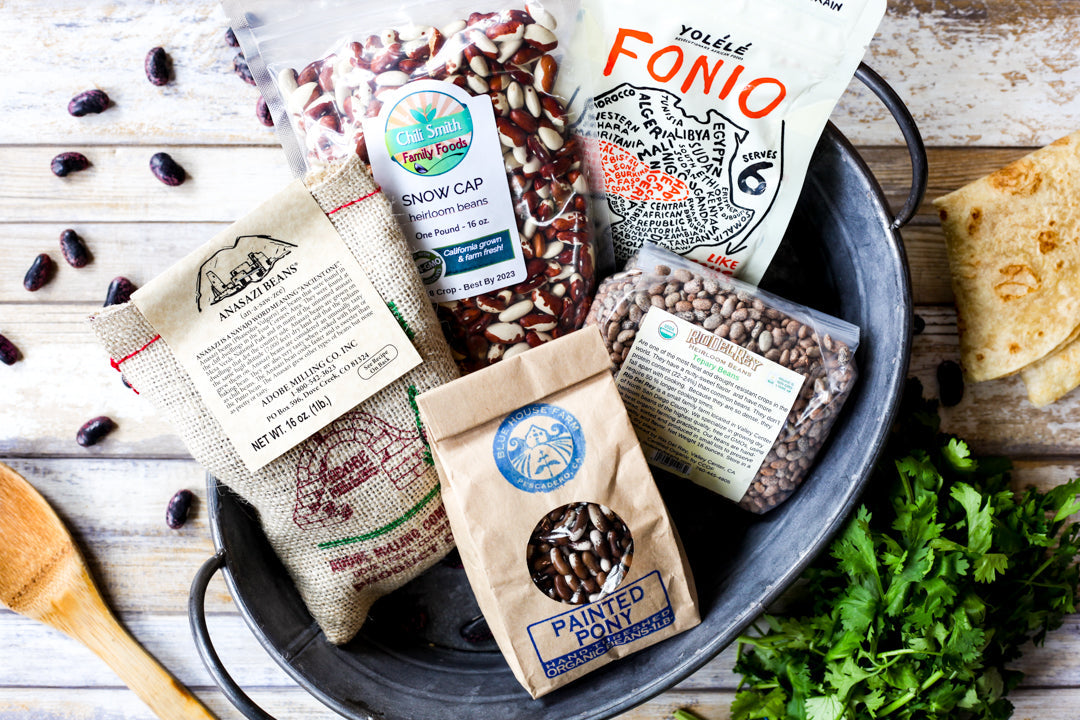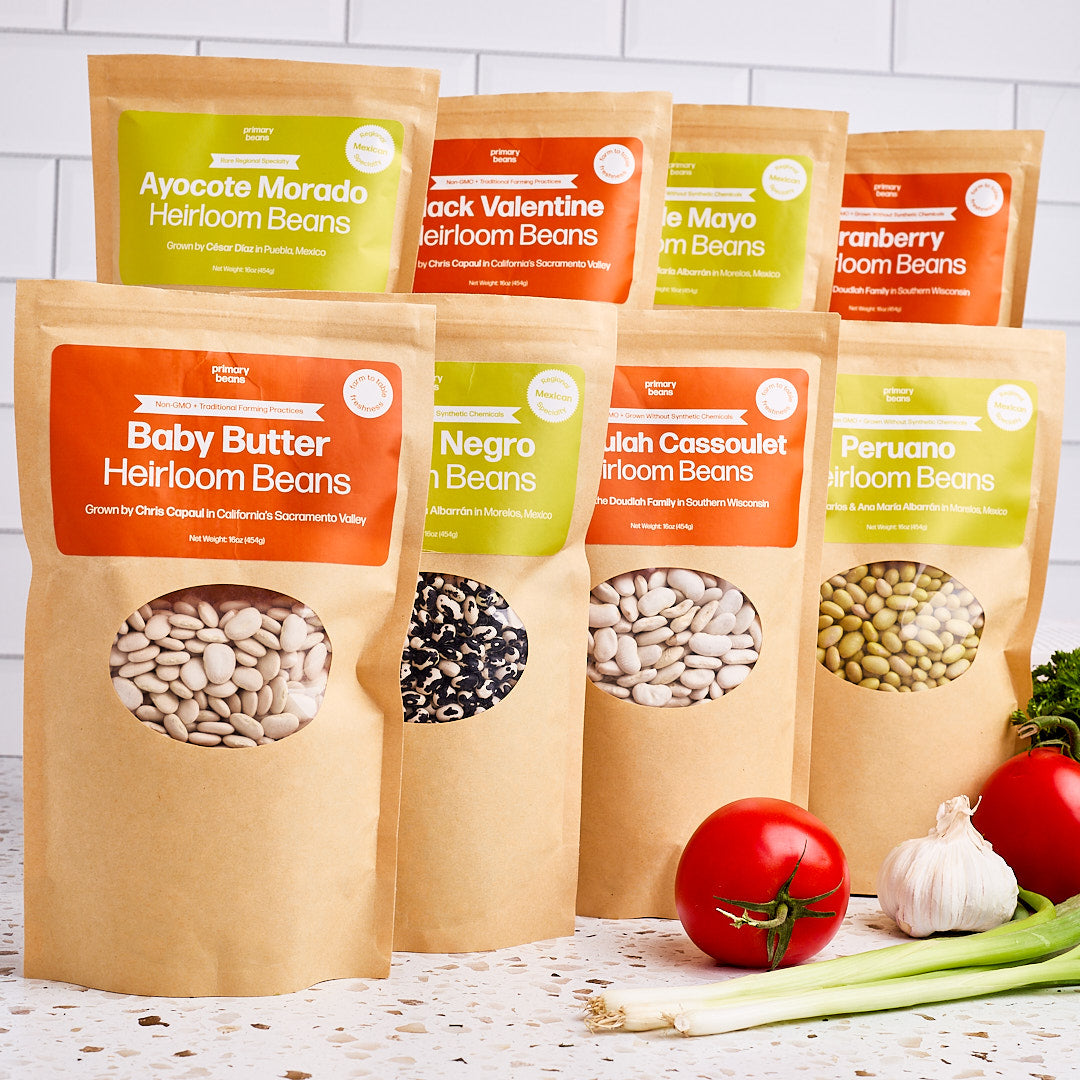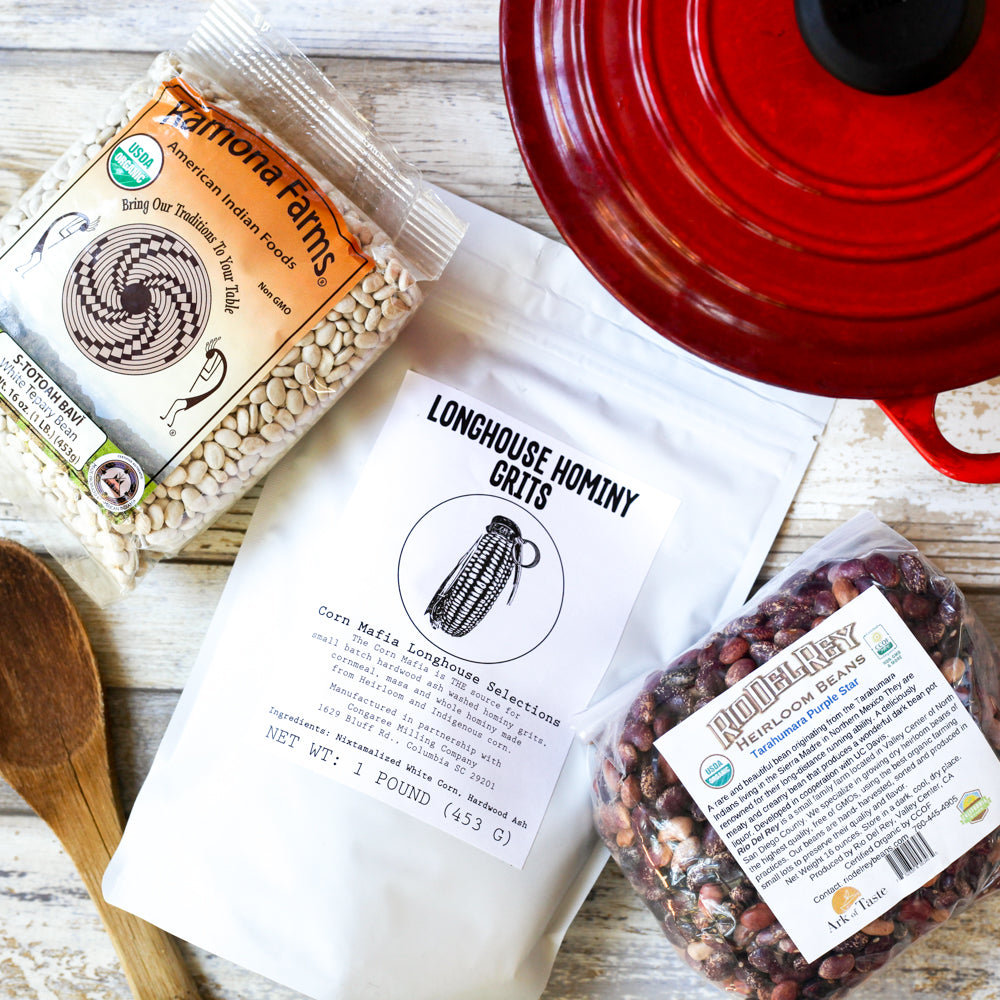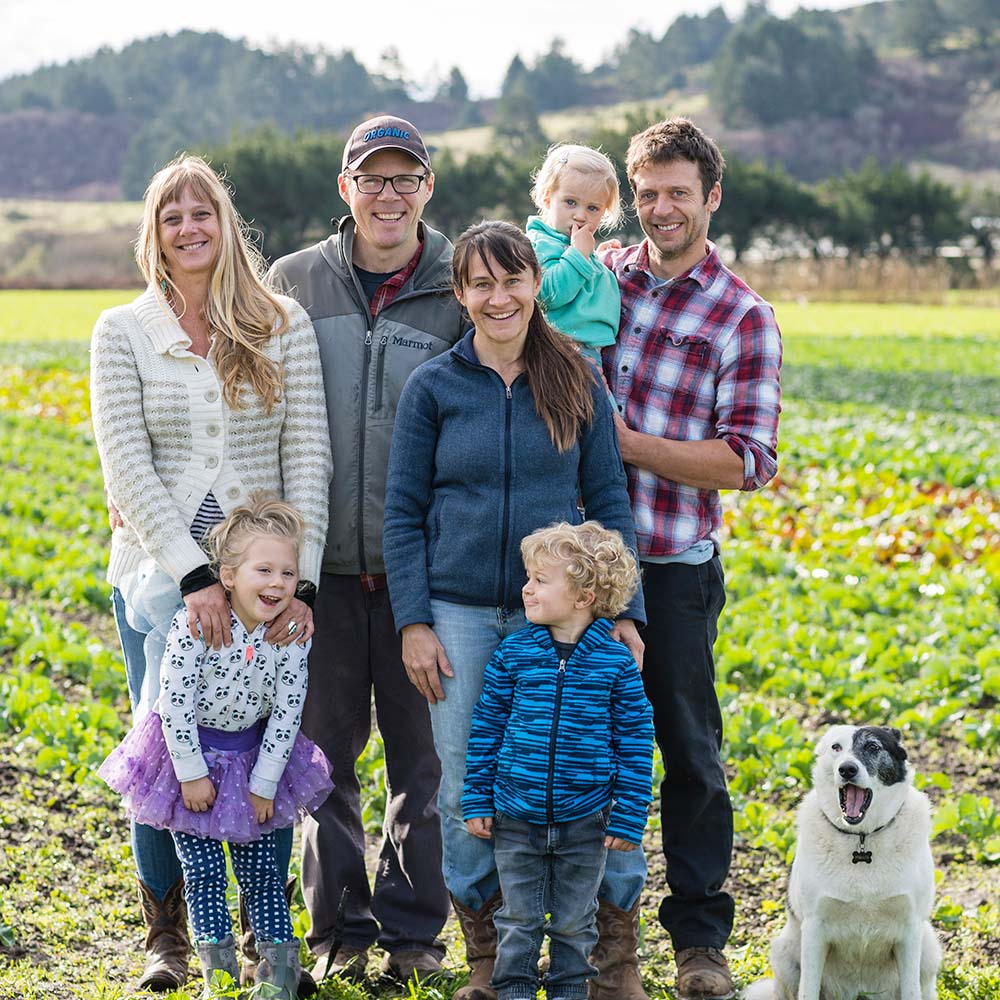10.99 FLAT RATE SHIPPING
10.99 FLAT RATE SHIPPING
SHOP

September Bean Club
August 25, 2021 7 min read
The September Heirloom Bean and Grain Box contains rare Slow Food Ark of Taste ingredients as well as organic, sustainably farmed beans and a gluten free ancient grain that's changing lives.
As summer comes to a close we're dreaming of cozy fall soups and stews and a big pot of beans simmering on the stove all day. A 3 bean chili comes to mind as football season starts. These show-stopping beans are bound to be a standout in all of your September kitchen adventures.
September Field Report
A massive drought and high heat this summer has scorched the land and decimated many bean crops. We are working hard to bring you the best beans available and help as many farmers as we can. We've started a Foodocracy Farm Fund to provide seed grants for women, minority and indigenous farmers who need our help. LEARN MORE >>

FAMILY BOX INCLUDES
Organic Painted Pony Beans from Blue House Farms
Organic Blue Speckled Tepary Beans (Ark of Taste)
Anasazi Beans
Snow Cap Beans
Fonio (Ark of Taste)
SMALL BOX INCLUDES
Organic Painted Pony Beans from Blue House Farms
Organic Blue Speckled Tepary Beans (Ark of Taste)
Fonio (Ark of Taste)
BEAN ONLY BOX INCLUDES
Organic Painted Pony Beans from Blue House Farms
Organic Blue Speckled Tepary Beans (Ark of Taste)
Anasazi Beans
ORGANIC PAINTED PONY
Beautiful brown and white mottled coloring that remains mostly intact after cooking gives this memorable bean its name. It has an elegant nutty flavor and a creamy texture with a thin skin that is beloved in soups, chili, with rice or pasta.
WHAT TO DO WITH THEM
The painted pony falls into the creamy category of bean. Think of it as a more flavorful and fancy cousin of the navy or pinto bean. These are very fresh so they cook up quicker than beans you'll get in the store. See our guide to cooking beans HERE but check them early because we found that cooking time was reduced. In the instant pot they went from dry to done in 20 minutes plus letting them rest on low for 10 minutes.
Because of it's distinctive coloring we're rather smitten with it in soups like this one by Emeril Lagasse. and this Vegan Mediterranian Bean Soup. We managed to find a unique recipe for vegan refried beans using painted pony and it's splendid.This comforting bowl of "Cowboy Beans" is an easy weeknight meal in the pressure cooker for meat eaters.

ABOUT THE FARM
Blue House Farm grows drop dead gorgeous beans from the gorgeous, fertile land in Pescadero and San Gregorio, California. Ryan Casey became interested in farming in college while taking agriculture courses. After completing an apprenticeship at the Center for Agroecology and Sustainable Food Systems and working on several farms, he decided to start an organic farm. The farm started in 2005 on 2 acres and has steadily grown to over 75 acres in production. Farming in two different microclimates allows Blue House Farm to grow over 50 types of certified organic farm products. Among the lettuce, tomatoes, herbs and peppers Blue House Farm grows excellent organic beans including the Painted Pony.

FRIOLES DE LA OLLA
Ingredients
Directions

ORGANIC BLUE SPECKLED TEPARY BEANS
This impossible to find variety of tepary bean was grown organically by Rio Del Rey Farms. It is a tiny speckled blue/grey bean that looks like lovely little river pebbles. Packed into the miniature bean is a deeply earthy flavor with a hint of minerality. It gives off a thick broth when cooked that is delicious on it's own. Tepary beans contain about more protein than other beans and are also higher in calcium, iron, niacin, magnesium and potassium.
Native American tepary beans have been grown for thousands of years in the Sonoran Desert. As one of North America's oldest foods it is recognized in the Slow Food Ark Of Taste. The tepary bean had a rich cultural history that stretched back more than six thousand years in the arid landscape of what is now Mexico and Southern Arizona. It was adapted by the indigenous people living this harsh desert climate to be nutrient dense as well as incredibly drought tolerant.
WHAT TO DO WITH THEM
That abundant, velvety bean broth makes these perfect for stews and soups but it also makes them wonderful to simply puree in their broth, add some spices and use as a dip or a spread as we've done here. We simply mashed the cooked tepary beans on toast with a fork, added some herbs and tomato, a drizzle of good olive oil (we suggest another Native American owned ingredient, the Seka Hills Piqual) and a sprinkle of Aleppo Pepper flakes and Pacific Flake Sea Salt.

ABOUT THE FARMER
If you've never heard of Rio Del Rey Farms and Mikes beautiful 100% organic heirloom beans, it's probably because they aren't sold in stores and they're really hard to get your hands on.
Mike is a lifelong champion of sustainability with a sophisticated palette. After cooking up a batch of Rio Zape he turned his full attention to preserving rare heirloom beans a decade ago. He has been tasting, testing, growing beans ever since.
ANASAZI BEANS
You'll find many a cook that waxes poetic about the many virtues of this beautiful little maroon and white mottled bean. It is thought to be an ancient ancestor of pinto beans because of the color but that's where the comparison stops. It is revered for not only it's sweet, dense flavor but also its quicker cooking times and the fact that there is no need to soak them.
Anasazi Beans have been grown by the Anasazi people in what is now called the four corners region of the United States dating back to at least 130 AD. They are sometimes called New Mexico Cave Beans because they were found in the ruins of their famous cave dwellings in New Mexico and Colorado.
These beans come to us from the Adobe Milling Company in Dove Colorado which holds a registered trademark on Anasazi name.
WHAT TO DO WITH THEM
These are exceptionally delicious and beloved by chefs. The fast cook time means they're probably the bag that will disappear the fastest out of your box. As with all beans we recommend at least cooking some with only salt and seasoning later. Cooking time on these is just 90 minutes to 2 hours WITHOUT soaking. If you need to soak because un-soaked beans are hard on your digestive system, Dr. Weil suggests soaking for 4-8 hours, changing the water and cooking for one hour. Remember to always salt the cooking and soaking water for the creamiest texture and to prevent your beans from exploding out of their skins.
We are obsessed with this elevated weeknight recipe for Anasazi Braised Supper Beans from Lynne Rossetto Kasper of The Splendid Table. Juniper berries are a common ingredient in indigenous cooking so we're crushing on this recipe for Anasazi Beans with Juniper Berries. The anasazi goes particularly well with southwestern food which is why we'll be making this southwestern vegetarian chili for football night this fall.
SNOW CAP BEANS
These distinctive beans have a lovely white "snow cap" surrounding a cappuccino colored bean about the size of a pinto bean. They keep most of their distinctive pattern when cooked. They have a soft texture (and some say a flavor) reminiscent of grandma;s mashed potatoes. Maybe that's the reason we love these so much in these genius crispy bean cakes from the New York Times.
FONIO
This delicious Ark of Taste ingredient comes to us from a passionate chef on a mission to introduce the cuisine of the African Diaspora to the world and lift up women living in poverty while doing it. Fonio is gluten free, cooks up fast and is incredibly versatile. With deep root systems, this ancient grain prevents soil erosion and needs little water. Labor intensive to harvest and process, fonio would have given way to corn and rice without the efforts of subsistence farmers. Considered one of the most important local species in West Africa, fonio has a fundamental role during the “soudure”, the period between harvest and the new cultivations, which is the most difficult period of the year to find food products.
WHAT TO DO WITH IT
Fonio is like a cross between cous cous and quinoa in both texture and flavor. It cooks up super fast similar to cous cous but is a gluten free ancient grain. It takes on whatever flavor you want and it doesn't get mushy. There are many recipes on the Yolele site from Chef Thiam but here are a few of our favorites Limpin' Susan, Veggie Sliders, Chocolaty Fonio Energy Bites, and a delicious Mushroom Risotto

ABOUT THE MAKER
Yolélé was founded in 2017 by Seneglese chef Pierre Thiam to create economic opportunity for smallholder farming communities; to support biodiverse, regenerative, and resilient food systems; and to share Africa’s ingredients and cuisines with the world. Yolélé is changing conditions for rural West African smallholder farmers. This population is among the world’s most vulnerable. Many young people seeking job opportunities simply leave, often to overcrowded cities where jobs are hard to find, or risk their lives on the dangerous path towards Europe.
Recent Articles
About Us
Foodocracy is dedicated to creating a more sustainable and independent food system. We support small, independent farms across the nation.
Get impossible to find beans and grains shipped direct to your doorstep each month from small family farms.
We support small, family owned farms across the nation. Did you know that farmers only make an average of 10 cents on every dollar you spend at the supermarket? Working directly with farms and not middle men ensures that more money goes back to the people actually growning your food.
Get 10% Off
Sign up for delicious recipes and special offers.
**Regularly priced items only.



